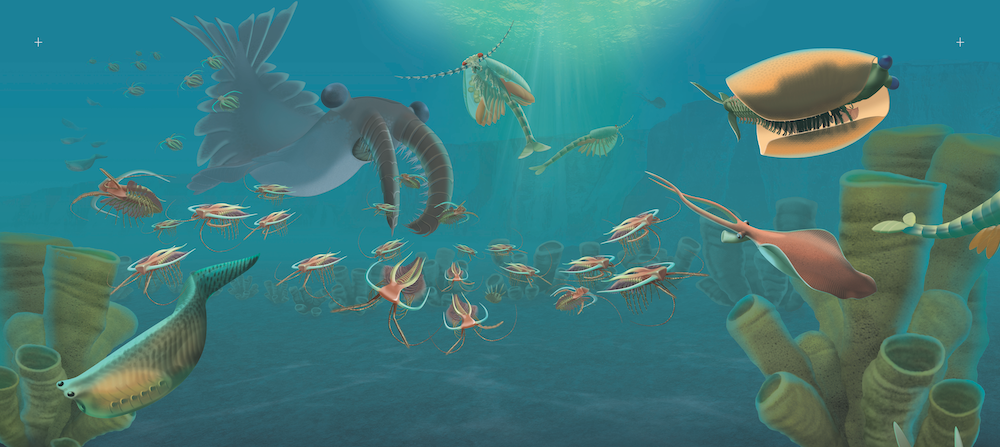Landmark New Gallery Opens at ROM: Willner Madge Gallery, Dawn of Life
Published
Category
Press Release
The story of life on Earth spans nearly 4 billion years of evolution, from the oldest records of life to the rise of the first dinosaurs

TORONTO, ON, (October 21, 2021) – On December 4, 2021, Royal Ontario Museum (ROM) unveils the Willner Madge Gallery, Dawn of Life—a new 10,000 square-foot state-of-the-art gallery that covers nearly 4 billion years of evolution from the earliest microbes to the emergence of dinosaurs and mammals in the aftermath of the biggest mass extinction event in history.
“This is a landmark moment in the history of the Museum,” says Josh Basseches, ROM Director & CEO. “This is the first major new permanent gallery to open at ROM in a decade and the first of its kind in North America. The Willner Madge Gallery delves into the fundamental mystery of life, where we came from, and how ecosystems as we know them began. Dawn of Life brings together ROM’s vast collection of fossils, decades of fieldwork, research, and groundbreaking scientific discoveries into a dedicated space to tell the epic story of life as it has never been told before. A story that begins in the very rocks of Canada. This remarkable new gallery has been funded entirely through visionary philanthropic support.”
The Willner Madge Gallery, Dawn of Life is located in Peter F. Bronfman Hall on Level 2, and will feature almost 1,000 fossil specimens, from 4 billion to about 200 million years ago, drawn extensively from ROM’s world-class palaeontology collections.
“Fossils are the ultimate messengers of the past,” says Dr. Jean-Bernard Caron, Dawn of Life’s lead curator and the Richard M. Ivey Curator of Invertebrate Palaeontology. “Having survived the ravages of time, they tell wondrous stories about life’s journey and how the modern world, including us, eventually came to be. In this gallery, we are telling the first 4 billion years of this long journey to the first dinosaurs.”
The Willner Madge Gallery, Dawn of Life is named in honour of Jeff Willner and Stacey Madge, who generously donated $5 million towards its creation. Jeff Willner is Board Chair of ROM Governors, which is responsible for all philanthropic activities in support of the Museum’s highest priorities.
"Stacey and I are proud and delighted to play a role in helping bring this extraordinary gallery to life,” says Jeff Willner. “This stunning narrative about life’s very beginnings is both Canadian and universal, compelling and relevant. The ROM's visionary team has created a special experience that is deeply meaningful. It’s much more interactive than typical museum displays, and I believe Museum visitors will be engaged and amazed by the story the gallery tells.”
At the heart of the gallery, are 12 “evolutionary gamechangers” that are key moments in the story of life on Earth. These include the emergence of animals originating in the Cambrian Period about a half-billion years ago, as well as the evolution of limbs from fish fins, roughly 375 million years ago—one of the adaptations that made it possible for vertebrates to live on land.
Dawn of Life also chronicles global environmental changes that altered the course of evolution, from the introduction of breathable oxygen into Earth’s atmosphere, to devastating ice ages and global warming events. Four of the five largest world mass extinctions are represented within the time frame of Dawn of Life, including the largest event 252 million years ago at the end of the Permian Period, which destroyed nearly 90% of life in the oceans.
The gallery will feature specimens from exceptional Canadian fossil deposits of great scientific significance, four of which are recognized as UNESCO World Heritage Sites. Each of these UNESCO fossil sites provide extraordinary fossil evidence of major intervals in life history, from oldest to youngest: Mistaken Point (Newfoundland and Labrador), the Burgess Shale from Yoho and Kootenay National Parks (British Columbia), Miguasha National Park (Québec) and Joggins Fossil Cliffs (Nova Scotia).
The 506-million-year-old Burgess Shale offers an incredible window into some of the Earth’s earliest animals that evolved during the Cambrian Period. This site is famous for the abundance, diversity and exceptional preservation of soft-bodied animals. Thanks to an ongoing ROM research program, the Museum holds the world’s largest and best collection of Burgess Shale fossils in trust for Parks Canada. The gallery will present nearly 200 fossils of the finest specimens from the Burgess Shale, showing the amazing diversity of animal life that existed in this marine Cambrian ecosystem. One such fossil, a soft-bodied jawless fish no bigger than a person’s thumb, called Metaspriggina walcotti, is one of our oldest relatives. But perhaps one of the best-known Burgess Shale animals is Anomalocaris canadensis, the top predator of the time, reaching up to a metre in length.
“The Burgess Shale fossils from Yoho and Kootenay National Parks are tremendously important to our understanding of ancient life and we are proud to protect and present these fossil sites,” says Ron Hallman, President & CEO, Parks Canada. “Parks Canada values its collaboration with the Royal Ontario Museum, from ongoing field research to the long-term care of the collections, and we are now especially thrilled to have the Burgess Shale showcased for Canadians, and the world, in such an iconic public museum.”
To bring the Burgess Shale to life, an amphitheatre-like area with 36 curved OLED screens will display a spectacular animation of what this ancient ecosystem might have looked like.
The gallery’s ROM Research Showcase will present the Museum’s latest Burgess Shale discoveries, displaying newly uncovered fossils and what they reveal about ancient life, such as Titanokorys gainesi,—a half-metre long, sea-dwelling arthropod with a giant head.
The fossil history of Ontario is also showcased in the gallery with a stunning collection of specimens discovered in the province. These fossils were formed during the Ordovician to the Devonian Periods (485-360 million years ago), in what is now Ontario when it was home to ancient marine life that thrived in shallow waters.
Dawn of Life feature fossils:
· The earliest currently known evidence of life comes from fossils of banded iron formation discovered near Inukjuak, Québec, which are between 4.28 to 3.77 billion years old and which have microscopic tubes made by microbes.
· Billion-year-old stromatolites (microbial formations) from Great Slave Lake, Northwest Territories, and Thunder Bay, Ontario. Following the evolution of photosynthesis, stromatolites released massive amounts of oxygen, helping make the Earth’s atmosphere breathable for the first time.
· Fossils of multicellular life, such as the standing frond Charniodiscus procerus, from Mistaken Point Ecological Reserve, a UNESCO World Heritage Site in Newfoundland and Labrador, record when “life got big” 575 million years ago during the Ediacaran Period.
· A magnificent trilobite collection from several provinces in Canada and all across the world including spectacular specimens from Russia and Morocco. Trilobites, a group of extinct arthropods, existed for hundreds of millions of years (since the beginning of the Cambrian Period), but were one of the groups of animals that died out by the end of the Permian extinction 252 million years ago, the biggest extinction event in history.
· The 375-million-year-old Eusthenopteron foordi, a lobe-finned fish, and Elpistostege watsoni, a transitional form, marked the way to early four-legged land animals during the Devonian Period and come from Miguasha National Park, a UNESCO World Heritage Site in Québec.
· The tree-like Sigillaria sp. stumps from the 319-million-year-old Joggins Fossil Cliffs (UNESCO World Heritage Site) in Nova Scotia, formed during the Carboniferous Period, contributed to an oxygen-rich world.
· Dimetrodon borealis, one of the most iconic fossils from the Permian Period, was first discovered in 1845 in PEI. The exhibit showcases the 285-million-year-old original historical specimen (the lower jaw) on loan for the first time to ROM for display, alongside a fully mounted cast skeleton.
· A 226-million-year-old ichthyosaur, Macgowania janiceps, from the Triassic Period deposits of Williston Lake, west of the town of Hudson's Hope, British Columbia, is a type of reptile that returned to a life in the seas (and is named after emeritus ROM curator Dr. Chris McGowan).
The gallery is designed to engage visitors of all ages through leading-edge presentation techniques and immersive technology so that families and kids can enjoy and learn together. Many of the fossils are brought “to life” through original ROM scientific artwork and animation, transforming ancient rock into brilliant living history and showcasing dozens of life-like reconstructions of organisms and environments by palaeoartists from Canada and around the world. Scientific works of art include large wall murals of palaeoenvironments; touchable bronze models including Acutiramus, a large Silurian Period arthropod predator that could reach more than two metres in length; large hanging models; dozens of 3D printed models of organisms from the Burgess Shale and Mistaken Point; and a huge cast of Mistaken Point rock surface that is several metres wide. Gallery visitors will be greeted by a life-sized model of Dunkleosteus, a giant armoured Devonian Period fish that had the strongest bite force of any living or fossil fish.
Among many digital experiences, a highlight will be a large multi-player interactive game where people can look for important fossils from Ontario. And to guide visitors through the gallery an audio tour is being produced for next year highlighting various stops along the way and include Indigenous perspectives.
With the addition of the Willner Madge Gallery, ROM will be able to tell the complete story of life on Earth. Beginning on the upper level of the Museum’s Rotunda area, visitors can travel chronologically through time from Dawn of Life into the James and Louise Temerty Galleries of the Age of Dinosaurs, then the Reed Gallery of the Age of Mammals and finally to the present-day with the Life in Crisis: Schad Gallery of Biodiversity, which then returns visitors full circle to the Rotunda. This also brings the ROM’s total gallery space devoted to palaeontology to nearly 25,000 square feet.
ROM is grateful to all supporters of the Willner Madge Gallery, Dawn of Life, which has garnered community funding from over 100 donors with gifts ranging from $10 dollars to $5 million. Contributions from across the community, in addition to Mr. Willner and Ms. Madge, made this gallery possible. Leadership donors include Richard M. Ivey & Family, The Salamander Foundation, Brookfield Partners Foundation, Rob Pitfield & Family, Elinor Gill Ratcliffe, TD Bank Financial Group, The Dorothy Strelsin Foundation, Louise Hawley Stone Charitable Trust, Jennifer Ivey Bannock, Albert and Barbara Milstein & The Polk Family Foundations, Anne Y. Lindsey, and Robert J. Dickinson Pyne.
This project is also made possible thanks to the acquisition or donation of invaluable specimens from many individuals or institutions, and the work of countless volunteers, students, and amateur enthusiasts who have dedicated time and expertise to the palaeontology collections at ROM. We also thank the following institutions for arranging long-term loans of specimens: Geological Survey of Canada, Canadian Museum of Nature, the Academy of Natural Sciences of Drexel University, and the Nova Scotia Museum.
-30-
Image Credit
The Cambrian Sea, illustrated by Marianne Collins, © Royal Ontario Museum
COVID-19
Admission to the Museum is limited and time-ticketed. Tickets should be purchased online to book a time slot. The Museum is following the advice of public health authorities and making every effort to help ensure visits are enjoyable, entertaining and, above all, safe, including wearing masks, social distancing and other precautions.
Beginning October 27, 2021, all visitors ages 12 and older must show proof of vaccinations when entering the Museum. See the online Visitor Guidelines for the most current COVID-19 protocols.
ROM COMMUNICATIONS
General: media@rom.on.ca
David McKay
Senior Communications Specialist
*Email is preferred during COVID-19 work-from-home protocols
ROM Social Media
#DawnOfLife
#BurgessShale
Instagram: @romtoronto
Facebook: @royalontariomuseum
Twitter: @MaryamATweets, @ROMToronto


